Report on Cerro Negro (Nicaragua) — March 1998
Bulletin of the Global Volcanism Network, vol. 23, no. 3 (March 1998)
Managing Editor: Richard Wunderman.
Cerro Negro (Nicaragua) February observations show decreasing fumarole temperatures
Please cite this report as:
Global Volcanism Program, 1998. Report on Cerro Negro (Nicaragua) (Wunderman, R., ed.). Bulletin of the Global Volcanism Network, 23:3. Smithsonian Institution. https://doi.org/10.5479/si.GVP.BGVN199803-344070
Cerro Negro
Nicaragua
12.506°N, 86.702°W; summit elev. 728 m
All times are local (unless otherwise noted)
A 14 February visit to Cerro Negro's crater revealed a general decrease in fumarole temperatures since Alain Creusot last measured temperatures there on 23 December 1996 (BGVN 21:12). The highest temperature found on his latest visit was 340°C. For comparison, in October 1996 fumarole temperatures were as high as 700°C.
Geological Summary. Nicaragua's youngest volcano, Cerro Negro, was created following an eruption that began in April 1850 about 2 km NW of the summit of Las Pilas volcano. It is the largest, southernmost, and most recent of a group of four youthful cinder cones constructed along a NNW-SSE-trending line in the central Marrabios Range. Strombolian-to-subplinian eruptions at intervals of a few years to several decades have constructed a roughly 250-m-high basaltic cone and an associated lava field constrained by topography to extend primarily NE and SW. Cone and crater morphology have varied significantly during its short eruptive history. Although it lies in a relatively unpopulated area, occasional heavy ashfalls have damaged crops and buildings.
Information Contacts: Alain Creusot, Instituto Nicaraguense de Energía, Managua, Nicaragua.

